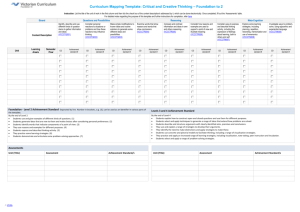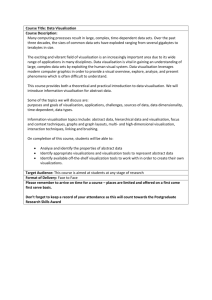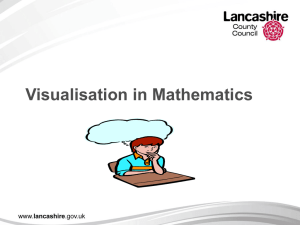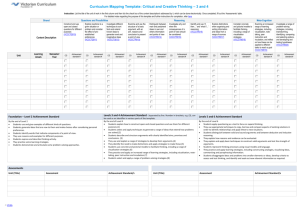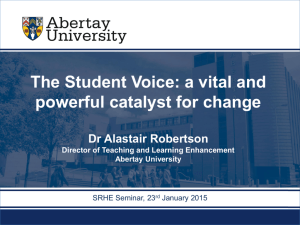Project Title: SimSages – visualising the urban
advertisement
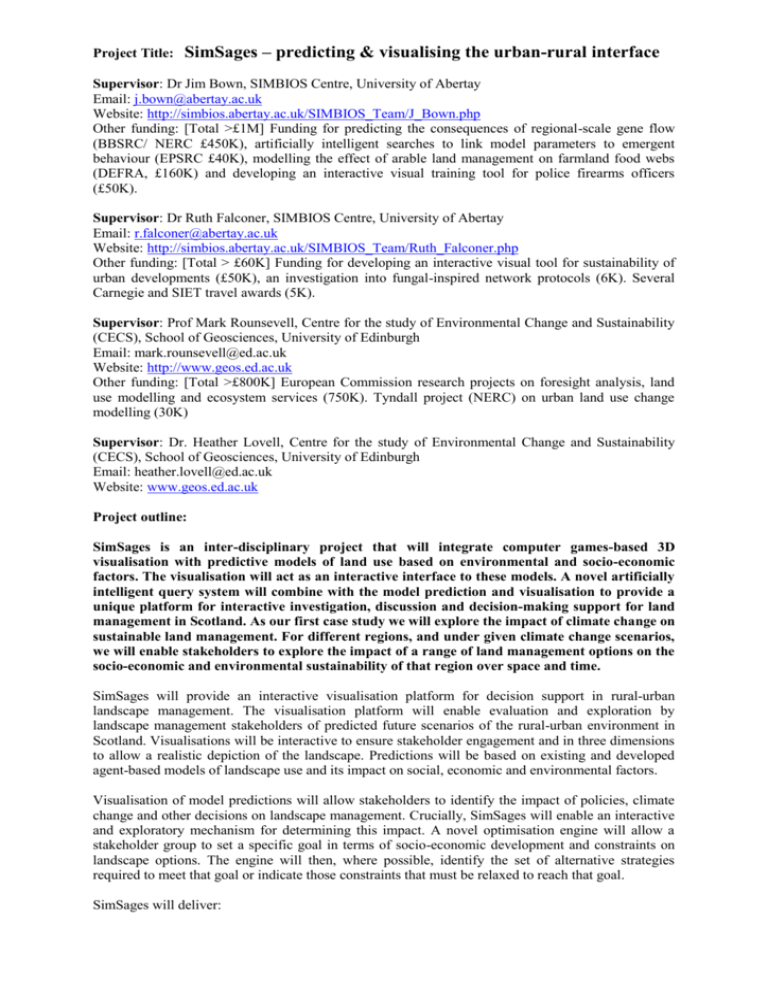
Project Title: SimSages – predicting & visualising the urban-rural interface Supervisor: Dr Jim Bown, SIMBIOS Centre, University of Abertay Email: j.bown@abertay.ac.uk Website: http://simbios.abertay.ac.uk/SIMBIOS_Team/J_Bown.php Other funding: [Total >£1M] Funding for predicting the consequences of regional-scale gene flow (BBSRC/ NERC £450K), artificially intelligent searches to link model parameters to emergent behaviour (EPSRC £40K), modelling the effect of arable land management on farmland food webs (DEFRA, £160K) and developing an interactive visual training tool for police firearms officers (£50K). Supervisor: Dr Ruth Falconer, SIMBIOS Centre, University of Abertay Email: r.falconer@abertay.ac.uk Website: http://simbios.abertay.ac.uk/SIMBIOS_Team/Ruth_Falconer.php Other funding: [Total > £60K] Funding for developing an interactive visual tool for sustainability of urban developments (£50K), an investigation into fungal-inspired network protocols (6K). Several Carnegie and SIET travel awards (5K). Supervisor: Prof Mark Rounsevell, Centre for the study of Environmental Change and Sustainability (CECS), School of Geosciences, University of Edinburgh Email: mark.rounsevell@ed.ac.uk Website: http://www.geos.ed.ac.uk Other funding: [Total >£800K] European Commission research projects on foresight analysis, land use modelling and ecosystem services (750K). Tyndall project (NERC) on urban land use change modelling (30K) Supervisor: Dr. Heather Lovell, Centre for the study of Environmental Change and Sustainability (CECS), School of Geosciences, University of Edinburgh Email: heather.lovell@ed.ac.uk Website: www.geos.ed.ac.uk Project outline: SimSages is an inter-disciplinary project that will integrate computer games-based 3D visualisation with predictive models of land use based on environmental and socio-economic factors. The visualisation will act as an interactive interface to these models. A novel artificially intelligent query system will combine with the model prediction and visualisation to provide a unique platform for interactive investigation, discussion and decision-making support for land management in Scotland. As our first case study we will explore the impact of climate change on sustainable land management. For different regions, and under given climate change scenarios, we will enable stakeholders to explore the impact of a range of land management options on the socio-economic and environmental sustainability of that region over space and time. SimSages will provide an interactive visualisation platform for decision support in rural-urban landscape management. The visualisation platform will enable evaluation and exploration by landscape management stakeholders of predicted future scenarios of the rural-urban environment in Scotland. Visualisations will be interactive to ensure stakeholder engagement and in three dimensions to allow a realistic depiction of the landscape. Predictions will be based on existing and developed agent-based models of landscape use and its impact on social, economic and environmental factors. Visualisation of model predictions will allow stakeholders to identify the impact of policies, climate change and other decisions on landscape management. Crucially, SimSages will enable an interactive and exploratory mechanism for determining this impact. A novel optimisation engine will allow a stakeholder group to set a specific goal in terms of socio-economic development and constraints on landscape options. The engine will then, where possible, identify the set of alternative strategies required to meet that goal or indicate those constraints that must be relaxed to reach that goal. SimSages will deliver: - - - A generic framework to visualise dynamically and interactively spatio-temporal data from agentbased model predictions of changes in land management, value and environmental metrics using stakeholder-defined parameters; An optimisation engine able to accept as input stakeholder-defined target end states and identify through artificially intelligent search the range of possible input parameters consistent with achieving that target; Conformance guidelines for other models and data to link into the framework, so providing a common platform for integration and visualisation of different facets of landscape management. To deliver this we will integrate and extend a suite of existing technologies. First, Rounsevell has a range of agent-based models to predict the evolution of land use based on management decisions made by individual agents. Those decisions have economic, societal and environmental impacts that feed forward into subsequent decision making processes. Second, Falconer has utilised computer game technology to develop an interactive visualisation tool for sustainable urban planning. The tool allows stakeholders to design urban areas in a virtual space (Figure 1), visualise that design in an interactive three-dimensional space allowing the user to travel around the area (Figure 2), and overlay onto the visualisation additional information such as energy use by different categories of building over time (Figure 3), noise pollution etc. The overlays are a result of an underlying sustainability model that determines the sustainability of an element (or elements) of the urban development i.e. building, road or green space in terms of its environmental, social and economic factors using stakeholder-defined parameters. Fig 1: Interface that allows flexible design of an any environment: an urban development is shown. Fig 2: 3D virtual environment is immersive as the user can navigate through the 3D world in first person. Fig 3: The visualization tool is coupled with an underlying sustainability model that allows predictions of how sustainable elements of the development are. Here, Carbon usage is being modelled and red reflects high Carbon usage and hence unsustainability. Finally, Bown has developed a sophisticated and generic optimisation engine. This engine is able to search the (input) parameter space of one or more computational models for parameter combinations that lead to a particular system-scale behaviour (output). This framework allows users to ask not only “what if …” questions, i.e. for a prescribed input what is the predicted output, but also the reverse query “if … what”, i.e. for a target end state (output) what is the required parameter set (input). Details of facilities etc.: The student will be based at Abertay within the SIMBIOS Centre and will be provided with a high specification PC for simulation and visualisation. This project will also be linked in with WhiteSpace, Abertay’s interdisciplinary research group comprising social scientists, computer artists and psychologists. WhiteSpace has a dedicated HIVE (Human Immersive Virtual Environment) ideal for the stakeholder engagement events described in the project outline and the student will have access to this. The HIVE is a 10m by 10m room with two large screens, each powered by workstation PCs, able to display three-dimensional images in stereo with rear projection to enable discussion of images at the screen. Summary of project (40 words for advertising): SimSages will provide an interactive visualisation platform for decision support in the management of urban-rural landscapes using agent-based models of landscape change. The visualisation platform will enable evaluation and exploration by landscape management stakeholders of future scenarios of the rural-urban environment. Importance of the project to SAGES and the Knowledge Transfer programme SimSAGES will be of great importance to the SAGES society theme and Themes 1-3. The proposed modelling and visualisation tools will provide an interface between a wide range of SAGES research activities and the stakeholders in Scotland with a role in landscape management and policy. SimSAGES is not just relevant to this research proposal because with appropriate development it has the potential to provide a lead in stakeholder interaction across many SAGES projects. The proposal is, therefore, of considerable strategic importance to knowledge transfer in SAGES. In addition to its role in knowledge transfer, the proposed research will also contribute to better understanding of the human and social processes that underpin landscape change. This will be achieved through the development and testing of the proposed modelling technology and use of the model to conduct virtual experiments that engage stakeholders. In this way, stakeholders and the societies they represent become an integral part of the analytical framework. Added Value The PR opportunities (an important KT activity in itself) are significant with access to the 3D immersive facility and the sophisticated visualisation algorithms. The HIVE has a large seating area together with a control and observation room for configuring the display, and is an excellent area for any PR SAGES events where externals can literally immerse themselves in the model and manipulate the inputs real time. The model will be developed initially for the Scottish environment, but due to its generic foundation, be applicable for any environment, at any scale.
